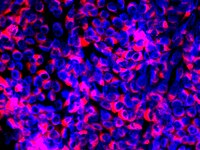
Photo from wikipedia
Bovine viral diarrhea (BVD) is an economically important cattle disease with worldwide distribution and characterized mainly by suboptimal fertility in the affected herds. The objectives of this study were to… Click to show full abstract
Bovine viral diarrhea (BVD) is an economically important cattle disease with worldwide distribution and characterized mainly by suboptimal fertility in the affected herds. The objectives of this study were to estimate the seroprevalence of BVDV within dairy cattle, to identify potential risk factors, and to assess the association with occurrence of reproductive problems. Sera (n = 954) collected from dairy cattle from 98 herds in southern and central Ethiopia were tested for BVDV antibodies using a commercial ELISA. Among screened sera samples, 20.9% (95% CI, 18.4, 23.6) tested positive to BVDV antibodies. The herd prevalence was 50% (95% CI, 40.1, 59.9) and the intra-herd prevalence ranged between 2.6 and 100% (mean = 31.4%) in positive herds. Geographic region, herd size, and animal arrangement in the farm had significant association with serostatus (p < 0.05). Cattle from southern Ethiopia and herds of large size had 2.8 (95% CI, 1.9, 4.2) and 2.6 (95% CI, 1.5, 4.6) times higher odds of being seropositive compared to their counterparts, respectively. Serostatus to BVDV was associated with history of anestrus, repeat breeding (RB), mastitis, and extended calving interval (CI) (p < 0.05). Animals with history of extended CI and mastitis were 1.7 (95% CI, 1.0, 2.7) and 2.2 (95% CI, 1.5, 3.2) times more likely to be seropositive compared with those with normal CI and no history of mastitis, respectively. On the other hand, animals with history of anestrus and RB were less likely to be seropositive to BVDV compared to cattle with no such history. Sera from 26 selected cattle were also examined using reverse transcription (RT)-PCR for detection of BVDV RNA; however, all samples tested were negative for the presence of BVDV nucleic acid. Our study highlights the variation in BVDV status within Ethiopian dairy herds, and association with some important reproductive performance traits and potential risk factors.
Journal Title: Tropical animal health and production
Year Published: 2021
Link to full text (if available)
Share on Social Media: Sign Up to like & get
recommendations!